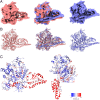Nanobodies and chemical cross-links advance the structural and functional analysis of PI3Kα
- PMID: 36095215
- PMCID: PMC9499577
- DOI: 10.1073/pnas.2210769119
Nanobodies and chemical cross-links advance the structural and functional analysis of PI3Kα
Abstract
Nanobodies and chemical cross-linking were used to gain information on the identity and positions of flexible domains of PI3Kα. The application of chemical cross-linking mass spectrometry (CXMS) facilitated the identification of the p85 domains BH, cSH2, and SH3 as well as their docking positions on the PI3Kα catalytic core. Binding of individual nanobodies to PI3Kα induced activation or inhibition of enzyme activity and caused conformational changes that could be correlated with enzyme function. Binding of nanobody Nb3-126 to the BH domain of p85α substantially improved resolution for parts of the PI3Kα complex, and binding of nanobody Nb3-159 induced a conformation of PI3Kα that is distinct from known PI3Kα structures. The analysis of CXMS data also provided mechanistic insights into the molecular underpinning of the flexibility of PI3Kα.
Keywords: chemical cross-linking; conformational changes; mass spectrometry; nanobody; phosphoinositide 3-kinase (PI3K).
Conflict of interest statement
The authors declare no competing interest.
Figures






Similar articles
-
Structural and mechanistic insights provided by single particle cryo-EM analysis of phosphoinositide 3-kinase (PI3Kα).Biochim Biophys Acta Rev Cancer. 2023 Sep;1878(5):188947. doi: 10.1016/j.bbcan.2023.188947. Epub 2023 Jun 30. Biochim Biophys Acta Rev Cancer. 2023. PMID: 37394020 Free PMC article. Review.
-
Cryo-EM structures of PI3Kα reveal conformational changes during inhibition and activation.Proc Natl Acad Sci U S A. 2021 Nov 9;118(45):e2109327118. doi: 10.1073/pnas.2109327118. Proc Natl Acad Sci U S A. 2021. PMID: 34725156 Free PMC article.
-
Calmodulin (CaM) Activates PI3Kα by Targeting the "Soft" CaM-Binding Motifs in Both the nSH2 and cSH2 Domains of p85α.J Phys Chem B. 2018 Dec 13;122(49):11137-11146. doi: 10.1021/acs.jpcb.8b05982. Epub 2018 Aug 8. J Phys Chem B. 2018. PMID: 30047727 Free PMC article.
-
Defining How Oncogenic and Developmental Mutations of PIK3R1 Alter the Regulation of Class IA Phosphoinositide 3-Kinases.Structure. 2020 Feb 4;28(2):145-156.e5. doi: 10.1016/j.str.2019.11.013. Epub 2019 Dec 9. Structure. 2020. PMID: 31831213
-
Calmodulin and IQGAP1 activation of PI3Kα and Akt in KRAS, HRAS and NRAS-driven cancers.Biochim Biophys Acta Mol Basis Dis. 2018 Jun;1864(6 Pt B):2304-2314. doi: 10.1016/j.bbadis.2017.10.032. Epub 2017 Oct 31. Biochim Biophys Acta Mol Basis Dis. 2018. PMID: 29097261 Review.
Cited by
-
Functional selection in SH3-mediated activation of the PI3 kinase.bioRxiv [Preprint]. 2024 Apr 30:2024.04.30.591319. doi: 10.1101/2024.04.30.591319. bioRxiv. 2024. PMID: 38746413 Free PMC article. Preprint.
-
Cryo-EM structures of cancer-specific helical and kinase domain mutations of PI3Kα.Proc Natl Acad Sci U S A. 2022 Nov 16;119(46):e2215621119. doi: 10.1073/pnas.2215621119. Epub 2022 Nov 7. Proc Natl Acad Sci U S A. 2022. PMID: 36343266 Free PMC article.
-
The essential roles of lncRNAs/PI3K/AKT axis in gastrointestinal tumors.Front Cell Dev Biol. 2024 Aug 5;12:1442193. doi: 10.3389/fcell.2024.1442193. eCollection 2024. Front Cell Dev Biol. 2024. PMID: 39161590 Free PMC article. Review.
-
Structural insights into the interaction of three Y-shaped ligands with PI3Kα.Proc Natl Acad Sci U S A. 2023 Aug 22;120(34):e2304071120. doi: 10.1073/pnas.2304071120. Epub 2023 Aug 16. Proc Natl Acad Sci U S A. 2023. PMID: 37585458 Free PMC article.
-
Discovery and Clinical Proof-of-Concept of RLY-2608, a First-in-Class Mutant-Selective Allosteric PI3Kα Inhibitor That Decouples Antitumor Activity from Hyperinsulinemia.Cancer Discov. 2024 Feb 8;14(2):240-257. doi: 10.1158/2159-8290.CD-23-0944. Cancer Discov. 2024. PMID: 37916956 Free PMC article.
References
-
- Fruman D. A., Regulatory subunits of class IA PI3K. Curr. Top. Microbiol. Immunol. 346, 225–244 (2010). - PubMed
-
- Arafeh R., Samuels Y., PIK3CA in cancer: The past 30 years. Semin. Cancer Biol. 59, 36–49 (2019). - PubMed
-
- McPhail J. A., Burke J. E., Drugging the phosphoinositide 3-kinase (PI3K ) and phosphatidylinositol 4-kinase (PI4K) family of enzymes for treatment of cancer, immune disorders, and viral/parasitic infections. Adv. Exp. Med. Biol. 1274, 203–222 (2020). - PubMed
Publication types
MeSH terms
Substances
Grants and funding
LinkOut - more resources
Full Text Sources
Miscellaneous

